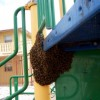Abstract
Honey bee swarms are a normal sign of a productive and strong honey bee colony. The population of honey bees in the environment grows and genes are exchanged as the new queen in the parent colony mates with drones from other colonies in the surrounding environment. Unfortunately, this activity often conflicts with the goals of the beekeeper, so good colony management includes swarm prevention. During the swarm season, hive owners should undertake proactive beekeeping practices to alter colonies in response to potential swarming behavior. In this way, the beekeeper maintains strong colonies with greater honey production and the potential to split and increase the total number of colonies, all of which makes beekeeping much more profitable for hive owners.
Originally published November 2012; updated July 2019.
References
Caron DM. 2006. Honey Bee Biology and Beekeeping. Cheshire, CT: Wicwas Press, LLC.
Delaplane KS. 2006. Honey Bees and Beekeeping: A Year in the Life of an Apiary. The University of Georgia and Keith S. Delaplane, USA. 108 pp.
Ellis JD, Ellis A. 2009. African Honey Bee, Africanized Honey Bee, Killer Bee, Apis mellifera scutellata Lepeletier (Insecta: Hymenoptera: Apidae). EENY 429. https://edis.ifas.ufl.edu/in790 (July 2019) https://doi.org/10.32473/edis-in790-2009
Ellis JD, Zettel Nalen CM. 2010. Using Nucs in Beekeeping Operations. ENY153. https://edis.ifas.ufl.edu/in869 https://doi.org/10.32473/edis-in869-2010
MAAREC (Mid-Atlantic Apicultural Research & Extension Consortium). 2000. Swarming-Control.
MAAREC Publication 3.4. https://canr.udel.edu/maarec/wp-content/uploads/sites/18/2010/03/Swarm_Prev_Control_PM.pdf (May 2022).

